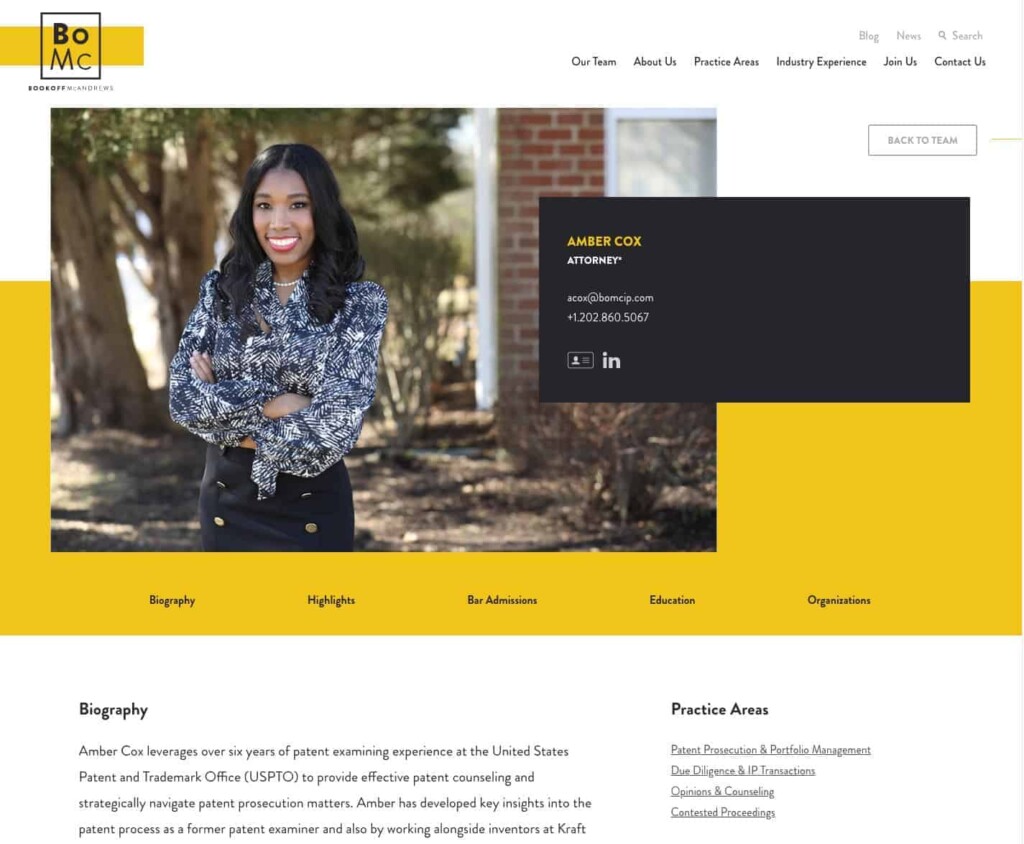How to Leverage Your Law Firm’s Website to Improve Attorney Recruiting
The struggle is real (and cyclical): law firms want to attract and hire top talent. In addition to top talent though, you’re looking for the perfect match of experience and alignment with your firm’s culture and core values. This is a tall order and getting it wrong can result in repeated cycles of recruiting, onboarding, and training.
As partners and recruiters know, poor talent fit is an expensive error. The Society for Human Resource Management (SHRM) estimates that “direct replacement costs can reach as high as 50%-60% of an employee’s annual salary.” When evaluating turnover across multiple practice areas and office locations, the cost of hiring errors can multiply quickly. Additionally, the result of low turnover with misaligned hires is just as costly. The longer a wrong hire stays, the more damage they can do to practice area morale, team productivity, client relationships, and most importantly, to the reputation of the firm.
These errors are avoidable and some intentionality behind one of your greatest recruiting tools will go a long way in setting your recruiting efforts up for success. Your law firm’s website can (and should) differentiate you from the competition and attract talent that will positively contribute to both your culture and your bottom line. It requires avoiding common misconceptions about law firm websites and specifically strategizing for the candidate experience. We cover four steps to attract the talent you want via your website.
Step 1: Clearly communicate your brand
Your brand identity is a critical element to attracting the right talent. If it isn’t clearly defined and communicated throughout your site, hit pause on other efforts and refocus attention toward your digital brand immediately.
Yes, it really should be prioritized above all else on your ever-growing to-do list. That’s because your digital brand is the foundational building block for everything your firm wants to accomplish on the web, from client and talent acquisition to practice area growth and beyond, it’s the key to achieving both your recruitment and revenue goals.

Similar to a physical structure, your digital presence also needs a solid foundation upon which to build. Your brand provides that foundation, informing major decisions like the information architecture, the prioritization of feature development, and it could potentially influence content management system (CMS) recommendations. It’s that important.
Remember, firms are competing for coveted talent. Before an attorney speaks with someone in your HR department, they’ve already examined your website, explored your attorney bios, tried to get a sense of what your firm is all about, and decided if they have any interest in exploring further. At this pivotal stage in the recruitment process, if your brand isn’t well-defined, neither a candidate (nor potential client) has a compelling reason to choose you over another.
Your brand identity is a competitive advantage and–especially as part of a digital experience–separates you from your competition.
The three P’s: Purpose, Proposition, Personality
Multiple components work together to create a comprehensive brand identity. A brand isn’t just your logo, colors, and fonts; it’s a visual representation of what you value and how you want to be perceived.
Harness the unique attributes of the firm and translate them into brand attributes. Use the Three P’s to convey your internal understandings of your firm to external audiences:
- Purpose = Brand Values | What do you stand for, and why do you do what you do?
- Proposition = Brand Messaging | What do you say to express your value, as a company, and your values?
- Personality = Brand Voice & Tone | Who are you & how do you express it?
If you’re finding it difficult to build brand consensus amongst your stakeholders, start by aligning on the elements of visual design before working through the three questions above to better prepare your team for the following steps.
Step 2: Narrow your funnel
Even for seasoned hiring professionals, determining if a candidate will be a culture fit can be challenging. While some recruiters value quantity over quality, time is valuable. The more clearly a firm articulates who they are as a brand, via their website, the earlier a candidate can determine if their values align with those of the firm (or not). This takes some of the onus off HR and empowers the candidate to make an informed, value-aligned decision before completing an application.
By deterring candidates who don’t align with the firm’s values, you proactively narrow the applicant funnel.
Did the mention of ‘Brand Values’ cause you to consider the core values of your firm? Do you have the core values memorized? Do your employees? To ensure you’re accurately articulating your brand values, review the firm’s core values and ask:
- How do they influence how we operate?
- How do they influence our culture?
- What drives the decisions we make on behalf of clients?
If core values aren’t a driving factor in decision-making at your firm, consider:
- Are there any public figures that embody the brand of the firm? (i.e. who would be a good spokesperson?)
- What characteristics do those public figures portray that we want our employees to emulate?
- How can we convey a holistic view of the employee experience at our firm?
Mass advertising can help build brands, but authenticity is what makes them last. If people believe they share values with a company, they will stay loyal to the brand.
Howard Shultz, former CEO of Starbucks
Wondering how brand loyalty differs from B2C and B2E scenarios? Interestingly enough, it doesn’t. Both customers and employees need a reason to develop loyalty, and brand values motivate each group to do so.
If candidates align with your brand values, they connect to the company on a more personal level. Once those candidates become employees, they’re more likely to be invested in the organizational goals, be highly engaged, and not be a source of voluntary turnover.
Step 3: Say what you mean (and mean what you say)
Few occupations regularly consume as much written content as attorneys. Whether they’re skimming bullet points or evaluating nuance, your content will be read. Don’t underestimate its value or miss the opportunity to tell your unique story.
Your site content should convey your brand personality, helping clients understand what it’s like to work with you and helping outside talent understand what it feels like to work for you.

Individuals, in general, have finely-tuned B.S. meters, and that’s especially true for attorneys. If your website isn’t an accurate representation of your brand and what a candidate can expect working for your firm, it’s not doing you any favors. Don’t attempt to polish all the personality (and reality) out of your brand to try and convey a “perfect” picture during recruitment. Be authentic and give candidates a true feel for what they can expect when they work for you. It’s your best shot finding hires that are truly aligned with your firm and more likely to stay over the long haul.
Step 4: Feature your people as a product
Last, but certainly not least, after you’ve communicated your brand identity, values, and brand voice throughout your site, reinforce them by highlighting your brand ambassadors. Showcase your attorneys; they’ve bought into your brand and are stewards of it to your clients and your industry.

While your firm provides services to clients, the people performing those services are ultimately the product the firm is selling. To new talent, the same rationale applies. That’s why it’s important to utilize attorney bio pages on your website as not only an important marketing tool but also a recruitment tool.
Candidates want to see who will be working alongside them and learn more about their potential colleagues. When strategizing your attorney bio pages, remember, what you decide to highlight in the bios says a lot about your culture to a potential candidate.
Consider the differences between these two approaches:
- Bios that include a practice area, individual awards, professional memberships, and links to published SME content
- Bios that include a practice area, alma mater, volunteer/charitable work, length of time at the firm, and/or other organization memberships and personal interests
What can you infer about each? At a glance, the first comes across as professional and focused on performance. There’s nothing inappropriate but also nothing that interesting. On the other hand, by recognizing employee contributions both inside and outside the office, the second appears to value personal connections, embody a culture of work/life balance, and opens a world of networking opportunities through school and personal information. Whatever your style may be, attorney bio pages should reflect your brand authentically and reinforce why top talent should work at your firm.
While many other steps are involved in your recruiting process, using your website as a window into your firm’s culture, values, areas of expertise, and its people is a critical component of your overall strategy. If recruiting is part of your law firm’s growth strategy and your website isn’t currently optimized for the candidate experience, we should talk.
